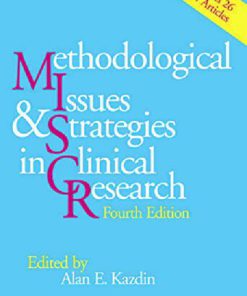Methodological Issues in Management Research Advances Challenges and the Way Ahead 1st Edition by Rabi Subudhi, Sumita Mishra ISBN 9781789739756 1789739756
$50.00 Original price was: $50.00.$25.00Current price is: $25.00.
Methodological Issues in Management Research Advances Challenges and the Way Ahead 1st Edition by Rabi Subudhi, Sumita Mishra – Ebook PDF Instant Download/Delivery: 9781789739756 ,1789739756
Full download Methodological Issues in Management Research Advances Challenges and the Way Ahead 1st Edition after payment

Product details:
ISBN 10: 1789739756
ISBN 13: 9781789739756
Author: Rabi Subudhi, Sumita Mishra
Methodological Issues in Management Research Advances Challenges and the Way Ahead 1st Edition Table of contents:
Chapter 1: The Methodological Domain in Management Research
Introduction
The Nature of Management Research
Dominant Research Paradigms
The Methodological Domain
Quantitative and Qualitative Research Methods
Triangulation in Management Research
Bridging the Quantitative Qualitative Divide
Contributions and Organization of the Book
References
Chapter 2: Reviewing the Literature
Introduction
Why Undertake a Literature Review?
Types of Literature Reviews
Systematic Literature Reviews
Integrative Literature Reviews
Narrative Literature Reviews
Pointers on Making Literature Reviews Effective
Evaluating Information Resources
Evaluating Articles Published in Scholarly Journals
Evaluating Books
Evaluating Web Resources
Referencing in Literature Reviews
Avoiding Plagiarism
Conclusion
Key Points
Questions
References
Chapter 3: Purpose and Process of Research
Learning Outcomes
3.1. Introduction
3.2. Three Purposes of Research – Exploration, Description, and Explanation
3.2.1. Exploratory Research
3.2.2. Descriptive Research
3.2.3. Explanatory Research
3.3. Thinking about a Suitable Research Area
3.4. Formulating Research Questions
3.5. Research Concepts and Constructs
3.6. Research Propositions and Hypothesis
3.7. Verifying Theory
3.8. Theory Building
3.9. Conclusion
Questions
References
Chapter 4: Research Design
Introduction
Developmental Research Designs
Longitudinal Design
Cross-sectional Design
Manipulation-guided Designs
Experimental Design
Quasi-experimental Design
Correlational Design
Pretest–Posttest Designs
Epilogue
Questions
References
Chapter 5: Questionnaire Design
5.1. Introduction
5.2. Types of Questionnaires
5.2.1. Exploratory Questionnaires/Unstructured Questionnaires with Open-ended Questions
5.2.2. Formal Standardized Questionnaires/Structured Questionnaires with Close-ended Questions
5.2.3. Semi-structured Questionnaires with Partially Structured Questions
5.3. The Steps Preceding Questionnaire Design
5.4. Preliminary Decisions in Questionnaire Design
5.4.1. Deciding on the Information Required
5.4.2. Define the Target Respondents
5.4.3. Choose the Method(s) of Reaching Target Respondents
5.4.4. Decide on Question Content
5.4.5. Develop the Question Wording
5.4.6 Opening Questions
5.4.7 Question Flow
5.4.8 Closing Questions
5.4.9. Physical Appearance of the Questionnaire
5.4.9.1. Use of Booklets
5.4.9.2. Simple, Clear Formats
5.4.9.3. Use of Color Coding
5.4.9.4. Interviewer Instructions
5.4.9.5. Piloting the Questionnaires
5.5. Open-ended Versus Close-ended Questions in the Questionnaire
5.6. Attributes of Writing a Good Questionnaire
5.6.1. Introduce Yourself
5.6.2. Explain the Purpose of the Questionnaire
5.6.2.1 Reveal What Will Happen with the Data You Collect
5.6.2.2. Estimate How Long the Questionnaire Will Take
5.6.2.3. Describe Any Incentives That May Be Involved
5.6.3. Make Sure Your Questionnaire Looks Professional
5.7. Distributing Questionnaire
5.7.1. Pilot Study
5.7.2. Disseminate Your Questionnaire
5.7.3. Include a Deadline
5.8. Use of Internet in Questionnaire Design for Smart Online Questionnaire
Useful Questionnaires
References
Appendix 1. South Asian Network for Development and Environmental Economics (Sandee) Research Projec
Chapter 6: Qualitative Interviewing
Introduction
Types of Interviews
Seven Steps of Interviewing Preparation
Preparing for Interviewing
References
Chapter 7: Focus Group Discussions
Introduction
Ontological and Epistemological Positions
Appropriateness of FGDs
Exploratory Focus
Explanatory Focus
Contextual Factors
When Not to Use FGD
Design of FGD
FGD Discussion Guide
Group Composition and Size
Facilitation Skills
Competencies Required for FGDs
Dealing with Silences
Recoding and Transcribing FGDs
Comparing FGDs and Interviews
Internet and FGDs
Ethical Considerations
Key Points
Questions
References
Chapter 8: Quantitative Data Analysis
Introduction
Scales of Measurement
Data Analysis Strategy
Univariate Analysis
Univariate Statistics
Multivariate Statistics
Cross-tabulation
Cross-tab Example
Independent Samples t-Test for Means
Paired Sample t-Test for Means
Pearson Correlation Coefficient
Partial Correlation and Rank Correlation
Regression Analysis
Multicollinearity
Factor Analysis
Steps of Designing a Factor Analysis
Factor Loading
Factor Rotation
Cluster Analysis
Applications of Cluster Analysis
Steps in Cluster Analysis
Outliers in Cluster Analysis
Assumptions in Cluster Analysis
Conjoint Analysis
Applicability of Conjoint Analysis
Steps in Conjoint Analysis
Assumptions in Conjoint Analysis
Multidimensional Scaling
Objectives and Application of MDS
Chapter 9: Testing of Hypothesis: Concepts and Applications
Introduction
Statistical Hypothesis
Types of Tests of Hypothesis
Concepts Basics to the Hypothesis-testing Procedures
Sample Testing
Type I and Type II Errors
Test Criterion
Usual Formulae for Sample Testing
Large Sample Tests
Cases.
Small Sample Tests
t-Test
Chi-Square (χ2) Test
Hypothesis for ANOVA
Critical Region and Tails of Tests
Example
Hypothesis Testing for a Population Proportion
Example
Two-tailed and One-tailed Tests of Hypothesis
Hypothesis Testing of Proportions: Large Samples
Two-tailed Tests of Proportions
Hypothesis Testing of Means When the Population Deviation Is Not Known
How Does It Work?
Solved, Application-oriented Examples
Example 1:Case of Sky-rocketing Real-estate Price
Example 2:Case of “Campus-placements and On-job-probation”
Exercise
1: Case: TV – viewers’ survey
2: Case: How Effective Is Mass Education Program of Govt. of India, Named, SSA and Other Interventio
Solution
Self-study Exercises
Self-practice Questions
References
Appendix 1
Chapter 10: Nature of Qualitative Research
Introduction
Meaning of Research
Research Is about Learning and Knowing
Good Research Happen When It Is Linked with Your ‘Being and Quest for Learning’
Concepts in Qualitative Research
Characteristics of Qualitative Research
Researcher Subject Relationship in Qualitative Research: Researcher and Research Are Inseparable
Main Steps in Qualitative Research
Broad Research Question
Broad Literature Review
Unit of Study
Eliciting Human Experiences
Data Churning
Interpretation of the Data
Conceptual and Theoretical Linkages and Significance of the Findings
Conclusion
Challenges in Conducting Qualitative Research
Doing of Qualitative Research: Flexibility and Immersion
Trustworthiness and Quality in Qualitative Research
Relevance of Qualitative Research: Discovery of New Phenomena and Self
Limitations of Qualitative Research
Key Points
Questions
References
Chapter 11: Case Study Research
Introduction
Components of a Case Study Design
Types of Case Study Design
Unit of Analysis
Sampling in Case Study Design
Replication in Case Study
Data Collection
Interviews
Focus Groups Discussions (FGDs)
Archival Data
Qualitative Analysis in Case Study
Structuring a Case Study
Methodological Issues in Case Research
Judging the Quality of Case Study Research
Conclusion
Key Points
References
Chapter 12: Grounded Theory: A Method of Research Inquiry
12.1. Emergence of Grounded Theory
12.1.1 Relevance of GT in Today’s Context
12.2. GT as a Method
12.2.1 Data Analysis
12.2.1.1 Theoretical Sampling
12.2.1.2 Theoretical Saturation
12.2.1.3 Theoretical Sensitivity
12.2.2 Coding
2.2.1 Open Coding – Categorizing Strategy
12.2.2.2 Axial Coding – Pattern Matching
12.2.2.3 Selective Coding
12.2.3 Memo Writing
12.2.4 Constant Comparison
12.3. Things to Remember for Beginners and Critical Evaluation
12.4. Conclusion and Future Scope of Research in GT
References
Chapter 13: Supplementary Research Methods: DEA, ISM, AHP and Non-Parametric Statistics
13.1 Non-Parametric Statistics
13.1.1 The χ2 (Pronounced Chi-squared) Tests
13.1.1.1 The One-sample Chi-squared Test
13.1.1.2 The Two-sample Chi-squared Test
13.1.1.3 Related-sample Chi-squared Test (or McNemar Test for Significance of Changes)
13.1.1.4 The Multi-sample Chi-squared Test
13.1.1.5 Using Chi-square for Contingency Coefficient
13.1.2 The Kolmogorov–Smirnov (K-S) Tests
13.1.2.1 One-sample K-S Test
13.1.2.2 The Two-sample K-S Test
13.1.3 The Runs Test
13.1.4 Mann–Whitney U-test
13.1.5 Spearman Rank Correlation Coefficient ()
13.1.6 Kendall Rank Correlation Coefficient (
13.1.7 Kendall Coefficient of Concordance
13.2 Interpretive Structural Modeling
13.2.1 The ISM Process Steps
13.2.2 An Illustrative Example
13.2.2.1 Listing the Factors Contributing to the Study Objective
13.2.2.2 Finding Contextual Relationships between Pairs of Variables
13.2.2.3 Converting the SSIM into a Reachability Matrix
13.2.2.4 Checking for Transitivity and Modifying the Reachability Matrix
13.2.2.5 Drawing the Digraph for the Reachability Matrix
13.2.2.6 Deriving the Model Levels by Iterative Partitioning of the Reachability Matrix (Level Parti
13.2.2.7 Draw the Factor Hierarchy
13.2.2.8 Making a MICMAC Analysis
13.3 Analytic Hierarchy Process
13.3.1 An Example Problem
13.3.2 The Weighted Average Method of Decision-making
13.3.3 Decomposing the Problem into a Hierarchy
13.3.4 Ratio Scale of Measurement
13.3.5 Paired Comparison
13.3.6 Priority Weights for the Criteria
13.3.6.1 The Method of Geometric Mean
13.3.6.2 The Eigenvector Method
13.3.7 Paired Comparison of Alternatives Against Each Criterion
13.3.8 Synthesizing the Priorities
13.3.9 Consistency of the Priority Weights
13.3.10 Extensions to the Basic AHP
13.3.10.1 Levels of Criteria
13.3.10.2 Group Decision-Making
13.3.10.3 Analytic Network Process
13.3.10.4 Dedicated Software Packages
13.4 Data Envelopment Analysis
13.4.1 Productivity and Technical Efficiency
13.4.2 The Charnes, Cooper, Rhodes (CCR) Model (Constant Returns to Scale)
13.4.2.1 Equivalence of the Fractional LP Problem with the LP Problem
13.4.2.2 Same Units of Measure
13.4.2.3 CCR Efficiency and Efficient Frontier
13.4.2.4 Reference Set or Peer Group
13.4.2.5 Interpretation of Optimal Weights
13.4.3 Examples
13.4.3.1 The Case of Multi-inputs and Multi-outputs
13.4.3.2 The BCC Model (Variables Returns to Scale)
References
Chapter 14: Special Section: Sample Research Papers
Chapter 14.1: Working with Second-order Construct in Measurement Model: An Illustration Using Empiri
14.1.1. Introduction
14.1.2. Research Methodology
14.1.2.1. Sample and Data Collection
14.1.2.2. Research Measures
14.1.3. Results and Findings
14.1.3.1. Reliability and Correlation of Constructs
14.1.3.2. Establishing Construct Validity
14.1.3.3. Conducting an EFA to Check Factor Structure
14.1.3.4. Conducting CFA to Establish Construct Validity
14.1.3.4.1. Reliability, Convergent, and Discriminant Validity of Constructs
14.1.3.4.2. CFA Model 3: EmpPerf as a Uni-dimensional First-order Construct
14.1.3.4.3. CFA Model 4: Measurement Model with TP and CP as Two First-order Constructs
14.1.3.4.4. CFA Model 5: EmpPerf as a Second-order Factor
14.1.4. Discussion and Conclusion
References
Chapter 14.2: Role of Self-Congruity in Predicting Travel Intention
14.2.1. Introduction
14.2.2. Literature Review
14.2.3. Methodology
14.2.4. Results
14.2.5. Findings and Discussion
14.2.6. Conclusion
References
Chapter 14.3: Structural Equation Modeling: Threshold Criteria for Assessing Model Fit
14.3.1. Introduction
14.3.2. Fit Indices
14.3.2.1 Absolute Fit Indices
14.3.2.1.1. Chi-square
14.3.2.1.2 Normed Chi-Square
14.3.2.1.3 Goodness-of-Fit Index (GFI)
14.3.2.1.4 Root Mean Square Error of Approximation (RMSEA)
14.3.2.2 Incremental Fit Indices (IFI)
14.3.2.2.1. Normed Fit Index (NFI)
14.3.2.2.2 Tucker Lewis Index (TLI)
14.3.2.2.3 Comparative Fit Index (CFI)
14.3.2.3 Parsimony Fit Indices (PFI)
14.3.2.3.1. Adjusted Goodness-of-Fit Index (AGFI)
14.3.2.3.2 Parsimony Normed Fit Index (PNFI)
14.3.3. GOF Values and Validity Test of Our Research Data Set
14.3.3.1 Confirmatory Factor Analysis (CFA)
14.3.4. Conclusion
References
Chapter 14.4: Socio-economic Development Disparity in India: An Inter-state Analysis
Introduction
Data and Selection of Variables
Methodology
Results and Findings
Conclusion
References
Chapter 14.5: Stages and Methods for Cleaning Large Secondary Data Using R
14.5.1. Introduction
14.5.2. Data Context
14.5.3. Data Collection
14.5.4. Data Cleaning Methodologies
14.5.4.1 Visual Inspection of Row and Columns
14.5.4.1.1 Rows and Columns Extent
14.5.4.1.2 Apparent Anomalies
14.5.4.1.3 Complete Case of Data
14.5.4.1.4 Review of Data and Check for Data-Type
14.5.4.2 Working with Variables
14.5.4.2.1 Modifying/Deleting Column Names
14.5.4.2.2 Logical Inconsistencies
14.5.4.2.3 Decisions in Dropping Observations
14.5.4.2.4 Outlier Treatments
14.5.5. Testing the Assumptions Required for Analysis
14.5.5.1. Multicollinearity
14.5.5.2 Normality
14.5.5.3 Heteroscedasticity
14.5.6. Conclusion
References
Appendix 1
Appendix 2: [R-Syntax]
Appendix: Statistical Tables
Index
People also search for Methodological Issues in Management Research Advances Challenges and the Way Ahead 1st Edition:
methodological problems meaning
methodological problems examples
methodological problems
examples of methodological issues in research
methodological problem
Tags: Rabi Subudhi, Sumita Mishra, Methodological Issues, Management Research, Advances Challenges, Way Ahead
You may also like…
Uncategorized
Audiovisual Translation Theoretical and Methodological Challenges 1st Edition Yves Gambier
Technique - Food Manufacturing
History - Middle Eastern History
Relationships & Lifestyle - Digital Lifestyle
Computers - Computer Science
Machine Learning in Signal Processing: Applications, Challenges, and Road Ahead 1st Edition
Medicine - Diabetes
Advances in Diabetes Research and Management 1st Edition Rana Noor (Editor)
Uncategorized
Methodological Issues and Strategies in Clinical Research 4th Edition Dr Alan E Kazdin Phd Editor
Arts - Architecture











